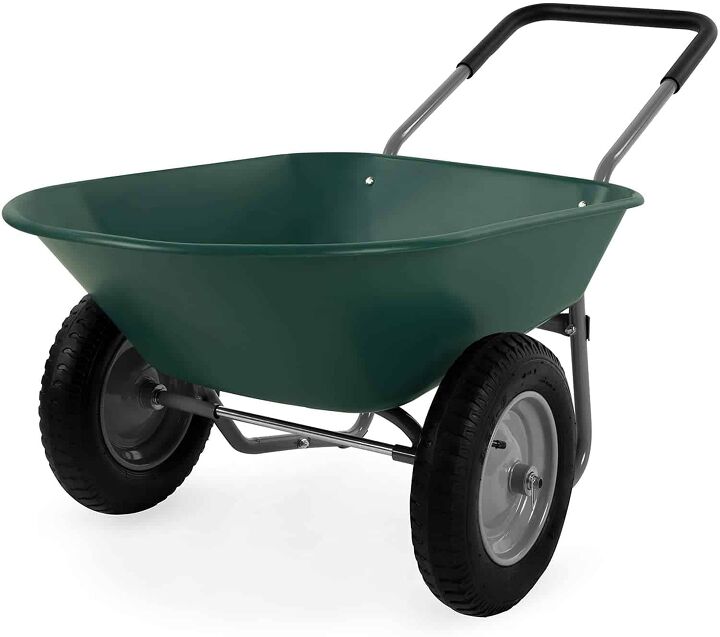25+ Different Types of Wheelbarrows

Undeniably, wheelbarrows are an essential tool for a variety of projects, niches, and virtually anything that requires the transportation of materials from one place to another. They are an incredibly versatile piece of equipment that can be used for everything from gardening to construction, and more.
Because of this reason, wheelbarrows are a very important tool to have in your collection. While you might think that wheelbarrows are pretty straightforward, this could not be farther from the truth.
Wheelbarrows can be categorized in a number of ways – such as bucket material, handle material, wheel design, strength, how it is propelled, and additional features. From manual and motorized wheelbarrows to single-wheeled and multi-wheeled to heavy-duty and light-duty wheelbarrows to stainless steel, plastic, and canvas, there are quite a few options to choose from.
If you’ve found yourself a bit overwhelmed in your search for the perfect wheelbarrow, we’re here to help! We’ve broken down all the different types of wheelbarrows available to help you make an informed decision on which is best for your purposes.
What is a Wheelbarrow?
Before we proceed with exploring the different types of wheelbarrows, it’s important to understand what exactly they are and their origins. Wheelbarrows are typically small, single-wheeled vehicles that are designed to carry small loads in their bucket. They are outfitted with handles at the rear that allow you to push and guide the wheelbarrow.
However, this definition describes the simplest form of the wheelbarrow, as there are modern models with multiple wheels and others that are motorized instead of manual.
The earliest known wheelbarrows came from China in the second century. A painting in a tomb, dated to 118 CE, displays a man pushing what we know as the modern-day wheelbarrow. There are a number of other ancient works of art, from similar time periods, that show wheelbarrows. Though, some stories claim that they may have existed even earlier – perhaps in the first century BCE.
How Do Wheelbarrows Work?
If you’re familiar with wheelbarrows, you likely are already aware of the basics. These tools feature a bucket that is used to hold materials, two long handles at the back, a wheel or wheels up front, and some sort of legs to rest on when not in use. Again, this is the simplest style of wheelbarrow and there are many different variations available nowadays.
However, with this standard style, the weight is evenly distributed between the barrow and the individual that operates it. Some variations have the wheel situated more in the center, which places all the weight on the barrow. Regardless, wheelbarrows are designed to help reduce the effort needed to perform a job. They are considered a compound machine, as they consist of two simple machines: a wheel and axle and a lever.
Types of Wheelbarrows
Wheelbarrows come in a range of handle styles, body styles, wheel styles, operating styles, and strengths. They can also be found with some additional features that add to the convenience of the machine. Each type of wheelbarrow comes with its own individual benefits, depending on the job you’re looking to perform.
Wheelbarrow Bucket Materials
The most common materials that are used in the construction of wheelbarrow buckets, or basins, are wood, plastic, and steel. Each of these materials comes with its share of advantages and disadvantages.
1. Stainless Steel Wheelbarrows
A popular material for wheelbarrow buckets, stainless steel presents no risk of rusting or corrosion. It is a durable and sturdy material that also offers resistance to destruction from the elements. With stainless steel wheelbarrows, you don’t have to worry about cracking when the tool is exposed to the sun, moisture, or excessively cold temperatures.
These types of wheelbarrows are very versatile and can be used for everything from transporting heavy loads around your garden or property to transporting supplies and products in an industrial setting. Oftentimes, you can find stainless steel wheelbarrows in a variety of colors and styles as well. Though the main drawback to this material is the fact that it is very heavy, which may make it difficult to maneuver for some individuals, and it will get hot when placed in the sun for an extended period of time.
2. Galvanized Steel Wheelbarrows
Galvanized steel, on the other hand, is susceptible to rusting but is still a very sturdy option for a wheelbarrow. If you are moving heavy materials such as stones or bricks, galvanized steel will hold up much better than wood or plastic. Unlike other alternatives, galvanized steel wheelbarrows will not bow or bend under excessive weight.
This material also stands up much better in the sunlight, over a longer period of time. Whereas, materials like plastic will weaken from being exposed to UV rays. Like stainless steel, galvanized steel is also very heavy and can be challenging to operate when full. Also, if left out in the rain, galvanized steel wheelbarrows will start to rust which can create a weak point in the basin.
Over time, this weak point will break and you’ll have to replace the entire wheelbarrow. Therefore, if you decide to opt for a galvanized steel wheelbarrow, make sure that you keep it stored in a covered area.
3. Powder Coated Steel Wheelbarrows
Generally speaking, powder-coated steel wheelbarrows have the same qualities, advantages, and disadvantages as galvanized steel. Though they do tend to look a bit more appealing, but this comes with its drawbacks.
Unlike galvanized steel or stainless steel, powder-coated steel wheelbarrows are susceptible to scratching if you are hauling pointed or sharp materials. So, consider an option for a different material if you’re going to be transporting things like rebar, gravel, or small sharp tools.
4. Plastic Wheelbarrows
As you might expect, plastic wheelbarrows are much lighter than their metal counterparts. This may be an important consideration, depending on the materials that you plan on transporting. Plastic also doesn’t pose any risk of rust or corrosion, which are inherent in steel wheelbarrows. Because of this, plastic wheelbarrows are perfect for moving materials like animal manure and fertilizer.
Plastic wheelbarrows are also considered a cost-effective option and are much cheaper than metal varieties, making them an excellent choice for folks on a budget. However, one of the main downsides to these wheelbarrows is the fact that the basic can crack under extremely heavy loads. Once a crack happens, it’s only a matter of time until the whole wheelbarrow needs to be replaced.
Another concern with plastic wheelbarrows is the fact that they will lose strength and may crack when left out in the hot sun or in extreme cold. In general, plastic wheelbarrows are much less durable than steel options.
5. Wooden Wheelbarrows
Wooden wheelbarrows are somewhat rare and are primarily used as planters for storage or aesthetic purposes. These types of wheelbarrows are environmentally-friendly, due to their biodegradable properties. Although they are not as prone to rusting like steel wheelbarrows or cracking like their plastic counterparts, they are susceptible to moisture damage.
When exposed to moisture or water for a long period of time, wooden wheelbarrows can expand, rot, or start growing mold. Because of this, it is highly recommended to store them in a covered area when they’re not in use. While wooden wheelbarrows are mostly used as decorative planters for ornamental plants and flowers, you can use them for light to medium-duty tasks around your property.
6. Canvas Wheelbarrows
While not nearly as popular as other basin materials, canvas wheelbarrows are available for ease of storage and loading of items. Their load tub is constructed out of durable canvas material and they typically have a metallic frame for stability. These wheelbarrows can be incredibly helpful around the home – especially for hauling large stable loads. Oftentimes, they have a ground flush design which makes loading and offloading much simpler.
Canvas wheelbarrows are foldable and flexible, meaning they can easily fit inside cabinets, underneath furniture, or tucked into the corner of a room. However, because of the flexible construction of canvas wheelbarrows, you may not be able to carry heavy loads or materials like sand, as it will pour out. When compared to other wheelbarrow types that have rigid load tubs, canvas wheelbarrows offer near-perfect weight distribution.
They are the ideal choice for those looking for a more affordable, lightweight, and storage-conscious wheelbarrow.
Wheelbarrow Handle Materials
The handles of your wheelbarrow will affect how easy it is to maneuver and dump the load. Although most wheelbarrows have two long wooden handles at the front of the wheelbarrow for easy leverage, they may be made out of a couple of different materials.
7. Wood
Wood handles are wildly popular on wheelbarrows, and for good reason. They won’t rust, are slightly more comfortable to grip than metal, have a bit of a flex to them, and won’t get hot in the sun. However, sometimes wooden handles can be rough or cause splinters. Although wood handles aren’t affected by the sun, they can become damaged if they’re left out in the rain.
The flex that wood handles have is great to help reduce extra strain on the upper body when you have to move multiple loads. Like wheelbarrows with wooden basins, the wet wood handles will eventually lead to rot. This can not only lead to mold growth, but it also lessens the overall lifespan of the wheelbarrow.
8. Metal
Metal, or steel, handles are another option for wheelbarrows. They offer security and will not splinter, bend, or break. The main drawback to metal handles is the fact that they will get hot when left out in the sun. However, this can be easily remedied by wearing gloves when the handles are too warm. Metal handles also have a long-lifespan and lower risk of becoming damaged.
9. Plastic
You’ll typically only find plastic handles on plastic wheelbarrows with an ergonomic single handle. The matching design and color yield a wheelbarrow with a very cohesive look, as pictured above. However, the color of the handle (and the wheelbarrow as a whole) can fade easily if left out in the sun for too long. Another concern with plastic handles is that they can crack or shatter when exposed to extremely cold temperatures.
This makes it challenging to use these types of wheelbarrows in winter or even late fall. A heavy load, pair with cold temperatures, will surely damage the wheelbarrow. Unfortunately, when plastic handles do break, usually the entire wheelbarrow has to be replaced since everything is connected.
Wheelbarrow Wheel Designs
Another way that you can categorize wheelbarrows is by the way the wheel (or wheels) are designed. Whether the wheelbarrow has one wheel or two can make a big impact on your decision and usually varies based on the wheelbarrow size.
1. Single-Wheeled Barrow
As the name suggests, this type of wheelbarrow consists of one wheel that is situated in the center of the wheelbarrow at the front. This is the most popular style of wheelbarrow, and likely the type that you may be most familiar with. It is essentially a tripod design, which makes maneuvering and dumping of the contents relatively easy.
Though, the drawback with this design is that it requires more strength on the part of the operator. You’ll need to have more upper body strength to maneuver a single-wheeled barrow and ensure that it stays balanced and doesn’t tip over. If you don’t, it’ll be very difficult to move things like firewood so you may want to opt for a wheelbarrow with two wheels.
2. Multi-Wheeled Barrow
While not as common as single-wheeled barrows, multi-wheeled barrows are increasing in popularity due to their ease of use. Additional wheels add more stability to the wheelbarrow, making this option work well for those with back problems or limited upper body strength. The extra wheel also works great for handling heavy or unbalanced loads.
Under this category, wheelbarrows with two wheels are the most common. However, they tend to be less easy to maneuver than single-wheeled barrows and can be challenging to operate on an incline. More specifically, they can be hard to navigate throughout a garden or other tight areas and should only be used on flat terrain.
Although double-wheeled barrows have less maneuverability than their single-wheeled counterparts, they are easier to use than three- and four-wheeled options.
3. Pneumatic Wheelbarrow
This type of wheelbarrow is outfitted with tires that can be inflated, similar to bicycle wheels. The tires have internal tubes that, when filled with air, act as a shock absorber. Because of this, these types of wheelbarrows are notorious for offering a smoother maneuvering experience – especially when transporting materials over rough terrain.
However, you’ll have to inflate the tires from time to time to achieve constant air pressure. Otherwise, you could unexpectedly experience a flat tire and you may have to replace the entire tire.
4. Non-Pneumatic Wheelbarrow
On the other hand, non-pneumatic wheelbarrows have solid rubber tires that will not go flat. Since they don’t have an inflatable inner air tube, these types can be used safely in rough conditions – including areas with cacti or sharp rocks. They will also perform well in extreme temperatures without any risk of the tire popping or puncturing.
Since these wheels don’t require regular air refills, non-pneumatic wheelbarrows are a low-maintenance variety.
5. Semi-Pneumatic Wheelbarrow
These wheels offer an excellent compromise between the pneumatic and non-pneumatic tops. Instead of internal air tubes, semi-pneumatic wheels are outfitted with internal air pockets that provide shock absorption without the need to pump air into them. They are also reliable enough to offer durability and sturdiness. This makes these types of semi-pneumatic wheelbarrows ideal for rough conditions, with little risk of going flat or getting punctured.
Wheelbarrow Strengths
Wheelbarrows can also be categorized based on their strength, or how heavy of a load they can handle. The three most common strengths that wheelbarrows can be broken down into include: heavy-duty, medium-duty, and light duty.
1. Heavy-Duty Wheelbarrows
Heavy-duty wheelbarrows are specially designed to handle robust transportation jobs. As such, they are ideal for use in a commercial or industrial setting. They are strong, durable, and have a higher weight and load capacity limit than other varieties of wheelbarrows.
However, they are generally more prominent with regard to size and weight, which makes them more difficult to maneuver. Heavy-duty wheelbarrows have the capability to handle at least eight cubic feet.
2. Medium Duty Wheelbarrows
Medium-duty wheelbarrows, on the other hand, have a size range between five to eight cubic feet. Most wheelbarrows on the market fall into this size range, with many of them being six cubic feet. For this reason, this particular size is the easiest to purchase in store or online. These wheelbarrows are big enough to handle transporting dirt, rock, plants, and other items. Though, they are still small enough to be easily maneuvered with minimal effort.
Though, when choosing a medium-duty wheelbarrow, make sure that the handles are strong enough to support the weight that you are moving and that the wheel is securely attached. You’ll typically find both single- and double-wheeled medium-duty wheelbarrows. You can also easily find medium-duty wheelbarrows available in plastic or steel.
3. Light Duty Wheelbarrows
Generally speaking, light-duty wheelbarrows are the most common variety. These are the types of wheelbarrows that you’ll likely see in a residential setting. When compared to heavy-duty wheelbarrows, light-duty wheelbarrows are smaller, more lightweight, and have a low weight and load capacity limit.
Their capacity only goes up to approximately five cubic feet, which is best suited for smaller and lighter tasks.
Manual Wheelbarrows vs. Motorized Wheelbarrows
Manuel wheelbarrows are the original and most common type of wheelbarrow. As the name suggests, they are propelled manually and require you to use physical energy to push them forward. This can become challenging when you’re hauling hefty loads. Manual wheelbarrows are not only the most common wheelbarrow available, they are also the most affordable.
Motorized, or powered, wheelbarrows, on the other hand, use electric power to propel the wheels. It does not require physical strength, leaving you with the task of simply maneuvering the wheelbarrow. Because of the nature in which they are operated, these wheelbarrows are best suited for heavy loads. For this reason, motorized wheelbarrows are commonly seen used in manufacturing and industrial environments.
You likely won’t see motorized wheelbarrows in a residential setting or being used by home gardeners. They come with a pretty high price tag and require more maintenance to keep them in good working condition. When compared to the standard manual wheelbarrow, the repair procedures are also much more complex.
Additional Wheelbarrow Features
Just like most other garden or home tools, there are many options and different customizations that wheelbarrow manufacturers offer. Here are some of the most common additional wheelbarrow features that you’ll likely come across, and what you should know about them:
1. Foldable
The ability to fold your wheelbarrow is an excellent feature to have, especially when storage is limited in your home. Foldable wheelbarrows make it easy to store the tool in your garage, underneath your carport, in a storage facility, or even inside your home.
Unlike standard wheelbarrows that are bulky and can be difficult to find a suitable storage location, foldable variants fold up easily into a compact design. When folded, they take up far less space, are incredibly lightweight, and easy to move around. Most foldable wheelbarrows feature a bucket that is made out of canvas, with a metal frame.
2. Ground Flush
Although they’re not nearly as common as standard wheelbarrows, ground flush wheelbarrows can be incredibly useful. This feature allows the wheelbarrow to lay flat on the ground, which makes it easier to transport items without having to lift them into the wheelbarrow.
These wheelbarrows offer simple operation; all you have to do is place the handles on the ground and then use a rake to put rocks, leaves, branches, or even firewood into the canvas basin. By lifting the handles, the basin is reformed, keeping the load secure and contained inside.
3. Non-Slip Grips
The best wheelbarrow handles will come with either a plasticized or rubberized grip, which creates a non-slip surface that makes it easier to maneuver the wheelbarrow. When you’re hauling an especially heavy load, it’s very helpful to have a strong and comfortable surface to grip onto without having to hold onto bare wood, plastic, or metal.
This is a great feature to have on metal handles, as it won’t get hot when exposed to the sun. It’s also helpful to have non-slip grips if your hands get wet while working. You won’t have to worry about your hands slipping and accidentally tipping over the wheelbarrow.
4. Ergonomic Handles
Ergonomic handles, when found on wheelbarrows, are either a closed or single bar. This design makes it a lot to push the machine from one place to the other and can be especially useful for younger individuals or the elderly. With these types of handles, you don’t have to exert as much effort to operate the wheelbarrow. However, the drawback to ergonomic handles is that they can be challenging to tip and dump the load.
Regardless, ergonomic handles are ideal for anyone that doesn’t have enough upper body or hand strength to haul a wheelbarrow in a straight line without accidentally running over plants in a garden.
5. Planters
Not all wheelbarrows are meant to be used to transport items and materials across a property. Some are designed as planters and can look lovely in from of nearly any style home – especially in a country setting. Generally speaking, wheelbarrows that are meant to be used as planters are smaller than traditional wheelbarrows. However, they are built to last so that they can withstand the elements.
In most cases, these wheelbarrows are constructed out of wood, which allows excess water to easily drain out of the base of the planter and prevents your plants and flowers from drowning. Of course, you may find plastic or metal planter wheelbarrows, though, it’s important that these have drainage holes in the bottom of the basin. Also, if you’re your planter wheelbarrows are made out of wood, they should be sealed to prevent rotting, mold, and pests.
6. Stainless Steel Peg Rests
When you set your wheelbarrow down between uses, it is set down on peg rests. Unless your wheelbarrow is outfitted with four wheels, it will have some sort of structure to rest on when it is not in use. Although these may come made out of wood, stainless steel is the best choice for peg rests.
Unlike wood, stainless steel peg rests won’t warp or bend under even the heaviest of loads and also won’t be impact by bugs.
7. Storage Racks
This is a relatively uncommon feature, but some wheelbarrows may come outfitted with additional storage racks. These racks may be positioned either on the sides of the tub or in between the handles. They allow you to store garden tools, mulch bags, and oddly-shaped items.
8. Rust Resistance
Unless you plan to use your wheelbarrow indoors (which is highly unlikely), you’ll want to choose one that will resist the elements. If you opt for a wheelbarrow that has a basin made out of plastic, the only concern will be sun damage from long-term exposure. On the other hand, if you get one made out of metal, it will be susceptible to rust. To avoid any rust issues, choose a wheelbarrow made out of stainless steel, plastic, wood, or canvas.
9. Ball Bearings
One often overlooked wheelbarrow feature is the ball bearing inside of the tires. The quality of the ball bearing will impact both the weight that your wheelbarrow can carry and also how fast and smooth the tires will be able to move along the ground.
For best results, choose a wheelbarrow that has a high-quality, industrial-grade ball bearing. These ball bearings have a longer lifespan and less of a risk of breaking down.
How to Choose the Right Type of Wheelbarrow
While selecting a wheelbarrow may not seem like a major life decision, to get the most out of your wheelbarrow, it’s important that you choose one that caters to your needs and will last you as long as possible. To do this, it’s important that you take a number of factors into consideration, including the following:
- Consider your needs. The first step in choosing the perfect wheelbarrow is determining your needs. For example, if you intend to haul large, heavy loads, you’ll need to opt for a heavy-duty wheelbarrow with a high weight limit and load capacity. On the other hand, if your needs are simpler or reserved for the garden, a plastic or wood wheelbarrow will work just fine.
- Quality and construction. The build quality and the materials used in the construction are major determinants in the durability of a wheelbarrow. If you’re looking for the most robust wheelbarrow, metallic or steel is your best bet. Since these wheelbarrows typically come with a high price tag, you can consider a sturdy wooden or plastic wheelbarrow. Aside from materials, it’s important to verify that all connections and joints are secure on the wheelbarrow that you purchase.
- Ease of maneuverability. Any garden tool that is difficult to maneuver is going to be a problem. With that being said, you should test out your wheelbarrow to ensure that it is easy for you to maneuver. Unless you intend to opt for one that’s heavy-duty, you may want to consider one that is compact and lightweight, with either one- or two-wheels tops. This guarantees that you’ll be able to maneuver it easily, even in the most confined of spaces. A heavier wheelbarrow will require more upper body strength and be much more difficult to maneuver.
- Capacity and weight limit. Depending on how much load you plan to haul, you’ll want to verify the weight limit and suitable capacity of the wheelbarrow you decide to invest in. Put simply, the lighter the materials that you plan to haul, the lower capacity you’ll need for your wheelbarrow. For heavy loads, you should opt for a wheelbarrow with a higher load capacity.
- Comfort and ease of use. Since you’re going to be the one pushing the wheelbarrow around, it’s important it is as comfortable to operate as possible. First, the handles should be the proper length, as handles that are too short can result in poor posture and back pain. For best results, the handles should be ergonomically designed to offer cushioning, comforting, and reduce the risk of slippage. When it comes to ease of use, a single-wheeled barrow is easy to maneuver, a double-wheeled design offers additional comfort and a three-wheeled variant is the easiest to operate.
- Type of terrain. The type of terrain that you plan to use your wheelbarrow on will determine the type, number of wheels, and overall design. For example, if you will be moving the wheelbarrow over rocky terrain, non-pneumatic wheels are ideal because the risk of punctured or flat tires is less. However, if you are transporting fragile items across rough terrain, you’ll want to choose a wheelbarrow with pneumatic wheels for shock absorption.
Steel vs. Poly Wheelbarrows – Which is Better?
In terms of durability and strength, steel wheelbarrows are undeniably the best. They can be safely loaded with stones, sand, bags, soil, firewood, and so much more. Steel wheelbarrows are also resistant to damage, inclement weather, and overloading.
However, plastic wheelbarrows are still a durable choice and, unlike steel, they won’t rust when exposed to the elements. These wheelbarrows are best suited for simple garden tasks, like hauling tools, flowers, and storage. If you still want a steel wheelbarrow but you’re concerned about rust, opt for stainless steel.
Related Questions
How durable are canvas wheelbarrows?
Although canvas wheelbarrows are constructed out of the most durable canvas material, they are a short-lived option when compared to alternatives. In most cases, you can expect these types of wheelbarrows to last about a year or two. Canvas wheelbarrows are not suited for tough tasks or heavy loads. It’s best to use these wheelbarrows only for transporting small or lightweight items, such as garden tools, flower pots, branches, leaves, and the like.
How much weight do wheelbarrows hold?
The weight that a wheelbarrow can hold will depend on its dimensions and construction – particularly the material of the basin – and the item that you intend to transport. With that said, standard wheelbarrows typically cannot carry more than 10 cubic feet.However, most wheelbarrows will have their volume capacity documented. Then, you can do a simple conversion to determine how much weight a wheelbarrow can hold. For example, a traditional eight cubic feet wheelbarrow can hold roughly 460 pounds of water or about 1,200 pounds of concrete.
Can wheelbarrows be recycled?
Since wheelbarrows are constructed out of a wide range of materials, there isn’t a one-size-fits-all answer to this question. They also may have one wheel or multiple, may have had components replaced, and vary in terms of purpose and size. Though, generally speaking, wheelbarrows can be dropped off at a local recycling center for reuse or placed curbside for bulky waste collection.However, you should consult your local municipal recycling to see if these services are offered in your community. Instead of recycling your wheelbarrow through your city, you can repurpose it in a number of different ways, including turning it into a planter or even a beverage cooler.
Can you rent wheelbarrows?
Wheelbarrows can be readily rented all over the United States at many home improvement centers, Home Depot included. The cost will vary depending on your location and the retailer your rent from. Though, the average cost to rent a wheelbarrow at Home Depot is $13 for four hours, $18 per day, $72 per week, and $216 for four weeks.

Jessica considers herself a home improvement and design enthusiast. She grew up surrounded by constant home improvement projects and owes most of what she knows to helping her dad renovate her childhood home. Being a Los Angeles resident, Jessica spends a lot of her time looking for her next DIY project and sharing her love for home design.
More by Jessica Stone


































